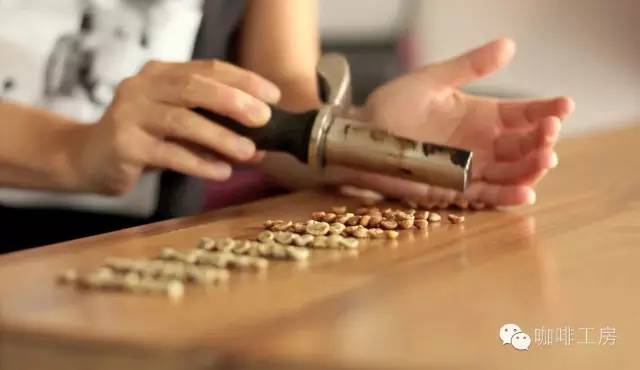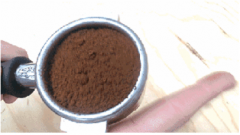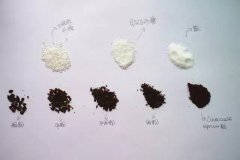The relationship between roasting degree and grinding degree of coffee the lighter the roasting degree of coffee beans is, the finer the grinding degree of coffee is.

Professional coffee knowledge exchange more coffee bean information please follow the coffee workshop (Wechat official account cafe_style)
How to judge and set the grinding degree of espresso
Fresh coffee beans are emerald green. Raw beans must be roasted, ground into powder, and then brewed before they become coffee in our cup. According to a book devoted to coffee, 80% of the taste of coffee is determined by roasting.
Baking, in short, is heating coffee beans for life. Heating will change and transform the chemical composition of raw beans, for example, starch will be converted into sugars and acids, plant fibers will be carbonized to a certain extent, water and carbon dioxide will volatilize, and proteins will become enzymes. The rest of the fat will be combined to form what we collectively call coffee oil. Coffee oil, a volatile substance, is precisely the source of coffee aroma, and because coffee oil is soluble in water, roasted coffee beans can be ground and brewed into fragrant coffee in our hands.
There are two very important stages to recognize in baking.
An explosion: the water and other substances in coffee beans produce carbon dioxide due to heat, so the cell wall is broken and the explosion is loud.
Second explosion: two minutes after the end of the first explosion, the temperature rises above 200 degrees, the cell wall of the coffee bean disintegrates, and the oil in the bean will spill at this time.
The first explosion and the second explosion can express the collapse of the cell wall of coffee beans, thus the chemical changes and the release of aromatic substances in the beans can be evaluated. The baking degree is traditionally determined by the time of the second explosion. SCAA has also introduced an Agtron color card to compare the caramel degree, making the baking degree more accurate.
Light Roast: very shallow baking, also known as "shallow baking", Agtron No.95
Time to drop beans: before and after the start of the explosion
Wind taste: bean table is light cinnamon color, with a strong grass flavor, taste and aroma is not enough, generally used for experiments, rarely used for tasting.
Cinnamon Roast: light baking, also known as cinnamon baking, Agtron No.85
Time to drop beans: an explosion begins to be dense.
Wind taste: the bean surface is cinnamon color, at this time the smell of grass has been removed, strong acidity, slightly fragrant, often used to make American coffee.
Medium Roast: medium baking, also known as "micro baking", Agtron No.75
Time to drop beans: from the explosion to the end
Wind taste: the bean surface is chestnut color, light taste, slightly sour with bitter, moderate aroma, retain the original flavor of coffee beans, often used as American coffee or mixed coffee.
High Roast: moderate micro-deep baking, also known as "concentration baking", Agtron No.65
Time to drop beans: the end of the first burst
Wind taste: the bean surface is light reddish brown, the taste is refreshing and rich, the sour and bitter balance is not irritating, and it is slightly sweet, with good aroma and flavor. Blue Mountain and Gillimazaro coffee are suitable for this roasting degree and are loved by people in Japan and Central and Northern Europe.
City Roast: medium and deep baking, also known as "urban baking", Agtron No.55
The time to drop the beans: after the first burst, that is, between the first and second bursts.
Wind taste: the bean surface is light brown, the taste is bright and lively, the acidity between sour and bitter balance is light, and it releases the high-quality flavor of coffee, which is the standard baking degree and the public's favorite roasting degree. Brazilian and Colombian coffee are suitable for this roasting degree and are often used in French coffee.
Full City Roast: micro-depth baking, namely deep baking, also known as "deep city baking", Agtron No.45
Time to drop the beans: the second burst
Wind taste: the bean surface is brown, the taste is calm and full, the bitter taste is strong, the aftertaste is sweet, the aroma is full, it is a Central and South American baking method, and more iced coffee and black coffee are used.
French Roast: deep baking, also known as "French baking", Agtron No.35
Time to drop beans: the second explosion is dense to the end of the second explosion.
Wind taste: the bean surface is dark brown and black, strong taste, bitter taste, sour taste almost no feeling, with rich chocolate and smoky aroma, for Europe by the most popular in France, more coffee Oulei, Viennese coffee.
Italian Roast: extremely deep baking, also known as "semantic baking", Agtron No.25
Time to drop the bean: the second explosion ends until the bean surface turns black and produces oil.
Wind taste: the bean surface is black and glossy. Before carbonation, the coffee bean fiber has a strong, complex, bitter taste, with strong roasting and scorching aroma. It is mainly popular in Latin countries and Italy. It is often used as Italian coffee Espresso.
Because of their different characteristics, different kinds of beans can show completely different flavors with proper baking methods.
Once the coffee bean is ground into powder, it will oxidize rapidly because of its larger contact with the air, and sometimes it will smell sour because of the oil it contains, so proper grinding is also related to the success or failure of a cup of coffee. Grind the coffee before brewing in order to retain the aroma of the coffee.
Different coffee brewing utensils need different grinding degrees, too coarse particles can not extract the taste, too fine and easy to over-extract, resulting in bitter taste, so the suitable extraction can extract the good ingredients of the coffee completely, and the inferior substances are retained in the fiber. in general, the shorter the brewing time, the more the coffee powder must expand the surface area to contact with the water, and the finer the particles are needed. On the contrary, if the cooking time is prolonged, the larger the grinding particles must be, the rougher the grinding particles must be, so as not to extract unnecessary impurities. For example, a fast-extracted Espresso requires extremely fine grinding like a fine powder, and a rough grind is required in order to fully infiltrate the coffee to release the aroma.
.
Important Notice :
前街咖啡 FrontStreet Coffee has moved to new addredd:
FrontStreet Coffee Address: 315,Donghua East Road,GuangZhou
Tel:020 38364473
- Prev

Effects of grinding methods, particle size and uniformity of coffee beans on coffee grinding degree and taste
Professional coffee knowledge exchange more coffee bean information please pay attention to coffee workshop (Wechat official account cafe_style) coffee bean grinding fineness how to judge and set the grinding degree of espresso Page 2 the effect of particle size and evenness on coffee taste 1 one ● preface the world's three major drinks are coffee, tea and cola, according to Taiwan
- Next

Common grinding of coffee powder in electric bean grinder how much is the grinding scale of hand-made coffee?
Professional coffee knowledge exchange more coffee bean information Please follow the coffee workshop (Wechat official account cafe_style) how to judge and set the grinding degree of espresso coffee friends who can brew coffee at home in their spare time should have a manual coffee grinder. If you are a barista, have a good study of coffee, or are coffee enthusiasts, you may
Related
- What is the Philharmonic pressure? How to use Philharmonic pressure to make delicious coffee
- Why does a hand grinder have more fine powder than an electric grinder?
- In addition to the hot mom, what is the difference between the versions of EK43 | ditting and Mahdi ek43?
- What kind of equipment do you need to make coffee by hand? Introduction to novice starter cooking equipment tools
- Espresso needs to be ground how thick and thin scale entry Italian Coffee Machine Bean Grinder investigation and Grinding course
- How much does it cost to open a small private cafe? How much does it cost to learn coffee? How to operate it?
- The difference between the flavor characteristics of hand-brewed coffee and coffee maker is hand-brewed coffee really better than coffee maker? Can I use a coffee machine to make coffee beans by hand?
- The difference between 01 and 02 of hario v60 filter cup what is the difference between 01 and 02 filter cup opening and cooking flavor
- What's the difference between the smart cup and the French kettle? Which is better, the French kettle or the Smart Cup?
- What's the difference between a smart cup and a V60 filter cup? The difference between the taste of smart cup and hand-brewed coffee

